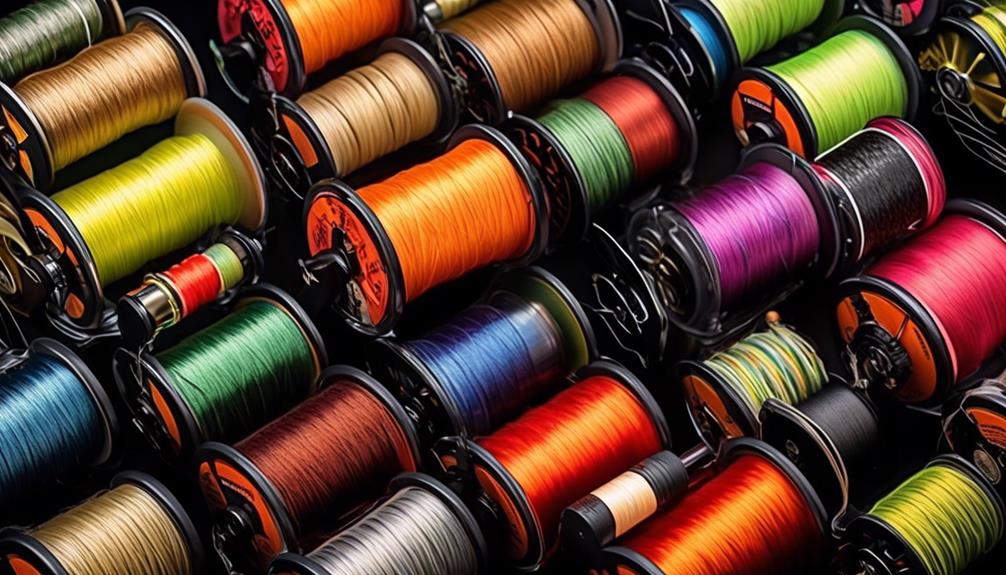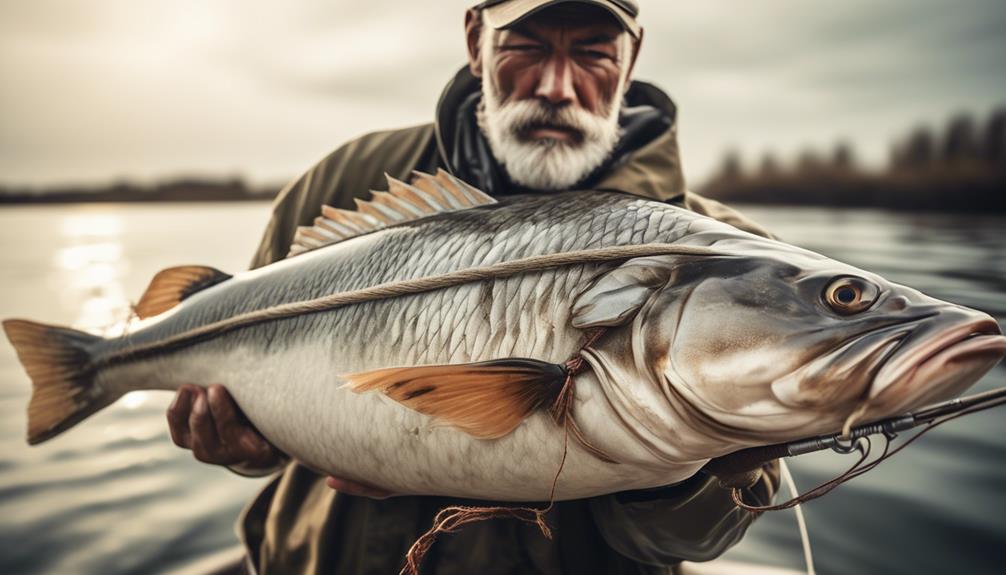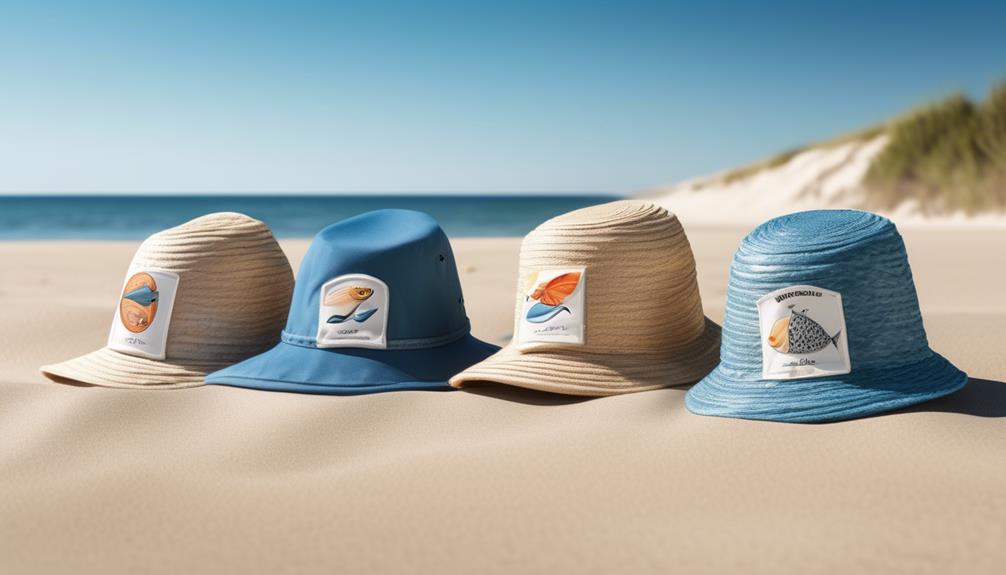You've probably heard the saying, 'You're only as strong as your weakest link.'
When it comes to fishing, the right fishing line can be the difference between a successful catch and a missed opportunity.
But why is it so important?
Well, imagine trying to reel in a big game fish with a line that isn't up to the task.
The right fishing line is crucial for a variety of reasons, and understanding its significance could significantly impact your next fishing excursion.
Types of Fishing Lines
Choosing the right fishing line is essential for your success on the water, as it greatly impacts your ability to land the perfect catch. There are three main types of fishing lines: monofilament, fluorocarbon, and braided lines. Each type has its own unique characteristics and is designed for specific fishing conditions.
Monofilament lines are the most common and affordable option. They're flexible and stretchable, making them a great choice for beginners. Monofilament lines float on water, which is advantageous for topwater fishing. However, they've more stretch than other types, which can make it harder to detect bites and set the hook.
Fluorocarbon lines are virtually invisible underwater, making them ideal for clear water conditions and wary fish. They've less stretch than monofilament lines, providing better sensitivity and hook-setting power. Fluorocarbon lines are also resistant to UV rays and abrasion, making them durable and suitable for various fishing techniques.
Braided lines are incredibly strong and have minimal stretch, allowing for excellent sensitivity and hook sets. They're perfect for fishing in heavy cover and for targeting large, hard-fighting fish. However, braided lines are highly visible in clear water and may require a leader for certain fishing situations.
Understanding the characteristics of each type of fishing line will help you choose the most suitable option for your fishing needs. It's important to consider the fishing conditions and the type of fish you're targeting when selecting the right fishing line.
Characteristics of Monofilament Lines
Monofilament lines, the most common and affordable option among the different types of fishing lines, offer unique characteristics that make them suitable for various fishing conditions.
One of the key features of monofilament lines is their flexibility. This flexibility allows for better shock absorption, making them ideal for fishing in waters with underwater structures or heavy cover.
Additionally, monofilament lines have a certain level of stretch, which can be advantageous when dealing with hard-fighting fish, as it acts as a buffer, preventing the line from breaking under sudden tension.
Another important characteristic of monofilament lines is their buoyancy. This buoyancy can be beneficial when fishing topwater lures, as it helps keep the lures afloat and visible to the angler.
Furthermore, monofilament lines are easier to handle and knot compared to other types of lines, making them suitable for anglers of all skill levels.
However, it's essential to note that monofilament lines have a higher degree of memory, meaning they can retain the shape of the spool, leading to tangles and loops.
Advantages of Fluorocarbon Lines
When selecting a fishing line, consider the advantages of fluorocarbon lines, which offer unique benefits for various fishing situations.
Fluorocarbon lines have become increasingly popular among anglers due to their distinct advantages over other types of fishing lines. Here are three key advantages of using fluorocarbon lines:
- Invisibility: One of the most significant advantages of fluorocarbon lines is their near-invisibility underwater. The refractive index of fluorocarbon is very close to that of water, making it almost invisible to fish. This property makes fluorocarbon lines ideal for clear water conditions and wary fish species. When fishing in highly pressured waters or targeting finicky fish, the low visibility of fluorocarbon can make a noticeable difference in getting more bites.
- Abrasion Resistance: Fluorocarbon lines are highly resistant to abrasion, making them suitable for fishing in areas with rough underwater terrain or sharp structures. This durability allows anglers to fish confidently around rocks, docks, and other abrasive surfaces without constantly worrying about line breakage. The enhanced abrasion resistance of fluorocarbon lines also makes them a reliable choice for targeting hard-fighting fish species.
- Sensitivity: Another advantage of fluorocarbon lines is their sensitivity, allowing anglers to feel even the subtlest of bites. This sensitivity is particularly beneficial when finesse fishing or targeting species known for their delicate takes. The ability to detect faint bites promptly can significantly improve hook-up ratios, ultimately leading to more successful fishing outings.
Benefits of Braided Lines
Considering your fishing needs and preferences, braided lines offer numerous benefits that can enhance your angling experience in various ways. Firstly, braided lines are known for their exceptional strength-to-diameter ratio. This means that they're much stronger than monofilament or fluorocarbon lines of the same diameter, allowing you to use a thinner line without sacrificing strength. As a result, you can cast further, feel more sensitivity when a fish bites, and have better control over your lure or bait.
Additionally, the lack of stretch in braided lines provides significant advantages. When setting the hook or trying to reel in a big catch, the minimal stretch in braided lines ensures that your actions translate directly to the bait or lure, increasing your hook-up ratio. Moreover, this lack of stretch also makes braided lines ideal for fishing in dense cover or thick vegetation, as it allows you to quickly pull the fish out of the snags without the line stretching and breaking.
Another benefit of braided lines is their long lifespan. Unlike monofilament lines that deteriorate over time due to exposure to sunlight and water, braided lines are highly resistant to these elements, ensuring durability and longevity. This means you won't have to replace your line as frequently, saving both time and money in the long run.
Considerations for Freshwater Fishing
For freshwater fishing, choosing the right fishing line is crucial for optimizing your angling success. When considering the best fishing line for freshwater fishing, there are a few important factors to keep in mind:
- Visibility: In the clear waters of freshwater lakes and rivers, the visibility of your fishing line is a critical factor. Fish in these environments tend to be more cautious, so using a low-visibility fishing line can greatly increase your chances of a successful catch. Opt for lines that are translucent or green in color to blend in with the surroundings and minimize the chances of spooking the fish.
- Strength and Sensitivity: Freshwater fishing often requires finesse and precision, especially when targeting smaller or more elusive species. Choose a fishing line that offers the right balance of strength and sensitivity. This will allow you to detect even the slightest nibbles and bites while still having the strength to reel in your catch without the line breaking.
- Abrasion Resistance: Freshwater environments can present various obstacles and hazards to your fishing line, such as rocks, debris, and submerged vegetation. Select a fishing line with high abrasion resistance to withstand these challenges and reduce the risk of line damage or breakage, giving you the confidence to navigate through different fishing spots without constant line replacements.
Considering these factors when choosing a fishing line for freshwater angling will significantly enhance your overall fishing experience and increase the likelihood of a successful and enjoyable outing.
Factors for Saltwater Fishing
Choosing the right fishing line for saltwater angling is essential for maximizing your chances of a successful catch in the challenging marine environment. When it comes to saltwater fishing, several factors need to be considered to ensure that your fishing line performs optimally.
Firstly, the corrosive nature of saltwater demands that you use a fishing line specifically designed to withstand the harsh saltwater conditions. Look for lines made from materials such as monofilament, fluorocarbon, or braided lines, as they're better equipped to resist corrosion and maintain their strength in saltwater.
Secondly, the strength and durability of the fishing line are crucial in saltwater fishing, as you may encounter larger and stronger fish species compared to freshwater. Opt for a fishing line with a higher pound test strength to handle the powerful pulls and runs of saltwater game fish. Additionally, consider the visibility of the fishing line in the water. In clear saltwater conditions, a transparent or low-visibility line is less likely to spook wary fish.
Furthermore, the stretch and shock-absorbing properties of the fishing line play a significant role in saltwater fishing. A line with some stretch can act as a buffer against the sudden bursts of energy from saltwater species, reducing the risk of the line breaking under pressure.
In saltwater environments, the right fishing line can make a substantial difference in your angling success. By considering factors such as corrosion resistance, strength, visibility, and shock-absorbing properties, you can optimize your gear for a productive saltwater fishing experience.
Best Fishing Lines for Different Techniques

When selecting a fishing line for different techniques, it's crucial to match the line's characteristics with the specific demands of the fishing method you intend to use. Here are the best fishing lines for different techniques:
- Monofilament Line: This type of line is great for topwater fishing and finesse techniques. Its stretchiness makes it a good choice for absorbing the shock of a fish's sudden movements, particularly when using treble hooks or fishing in areas with a lot of cover. Additionally, monofilament line floats, making it ideal for lures that need to stay near the water's surface.
- Fluorocarbon Line: Fluorocarbon is virtually invisible underwater, making it perfect for techniques that require a stealthy presentation, such as drop-shotting and jigging. Its low visibility and high sensitivity allow for better feel and control, especially in clear water or when targeting finicky fish. Fluorocarbon's abrasion resistance also makes it suitable for techniques that involve dragging baits along the bottom.
- Braided Line: This type of line is best for techniques that require strong hook sets and sensitivity, like flipping and pitching, as well as fishing heavy cover where you need to wrench fish out quickly. Its high strength-to-diameter ratio provides excellent sensitivity, allowing you to detect even the slightest bites, and its lack of stretch ensures solid hook sets, making it a favorite for many anglers in various heavy cover situations.
Importance of Matching Line to Fish Species
Selecting the right fishing line that matches the specific characteristics and behavior of the fish species you're targeting is essential for maximizing your chances of a successful catch. Different fish species have varying behaviors, feeding habits, and habitats, and using the appropriate fishing line can greatly impact your ability to reel in a prized catch.
When targeting large, aggressive species such as muskie or pike, it's crucial to use a heavy-duty braided line that can withstand their powerful strikes and sharp teeth. In contrast, when pursuing finicky, line-shy fish like trout or bass in clear waters, a light fluorocarbon line that's nearly invisible underwater can significantly increase your chances of getting a bite.
Matching your line to the fish species also involves considering their habitat. If you're fishing in rocky areas where sharp edges can easily fray the line, a durable monofilament line may be the best choice.
Moreover, the size and strength of the fish you're targeting should dictate the pound test of your line. Using a line that's too light when targeting large fish can result in break-offs, while using a line that's too heavy when targeting smaller fish may reduce your ability to feel bites and set the hook effectively.
Frequently Asked Questions
What Are the Common Mistakes Anglers Make When Choosing the Right Fishing Line?
When choosing the right fishing line, common mistakes anglers make include not considering the target fish species, neglecting the line's weight and strength, and overlooking the fishing environment. These factors significantly impact your fishing success.
How Can Weather and Water Conditions Affect the Choice of Fishing Line?
When choosing a fishing line, consider weather and water conditions. Opt for a heavier line in rough weather and murky waters, and a lighter line in calm weather and clear waters. This ensures better performance and success.
Are There Any Specific Regulations or Restrictions Regarding Fishing Lines in Certain Locations?
In some locations, specific regulations or restrictions may be in place regarding the type of fishing line you can use. It's important to research and follow these guidelines to ensure compliance and protect the environment.
What Are the Potential Environmental Impacts of Using Different Types of Fishing Lines?
When fishing, the right line choice is crucial as it affects the environment. Some lines can harm marine life, while others are more eco-friendly. Choosing the appropriate fishing line can help minimize negative environmental impacts.
Can Using the Wrong Fishing Line Affect the Behavior and Habits of Fish in a Particular Area?
Using the wrong fishing line can disrupt fish behavior and habits in an area. It may lead to decreased fish population, altered feeding patterns, and increased stress. Ensuring the right line is crucial for conservation.
Conclusion
So, now you know why the right fishing line is crucial for your success on the water.
Whether you're fishing in freshwater or saltwater, using the appropriate line for your technique and target species can make all the difference.
Remember to consider the characteristics of monofilament, fluorocarbon, and braided lines, and always match your line to the fish you're after.
With the right line, you'll be well-equipped to reel in the big one.
Happy fishing!



